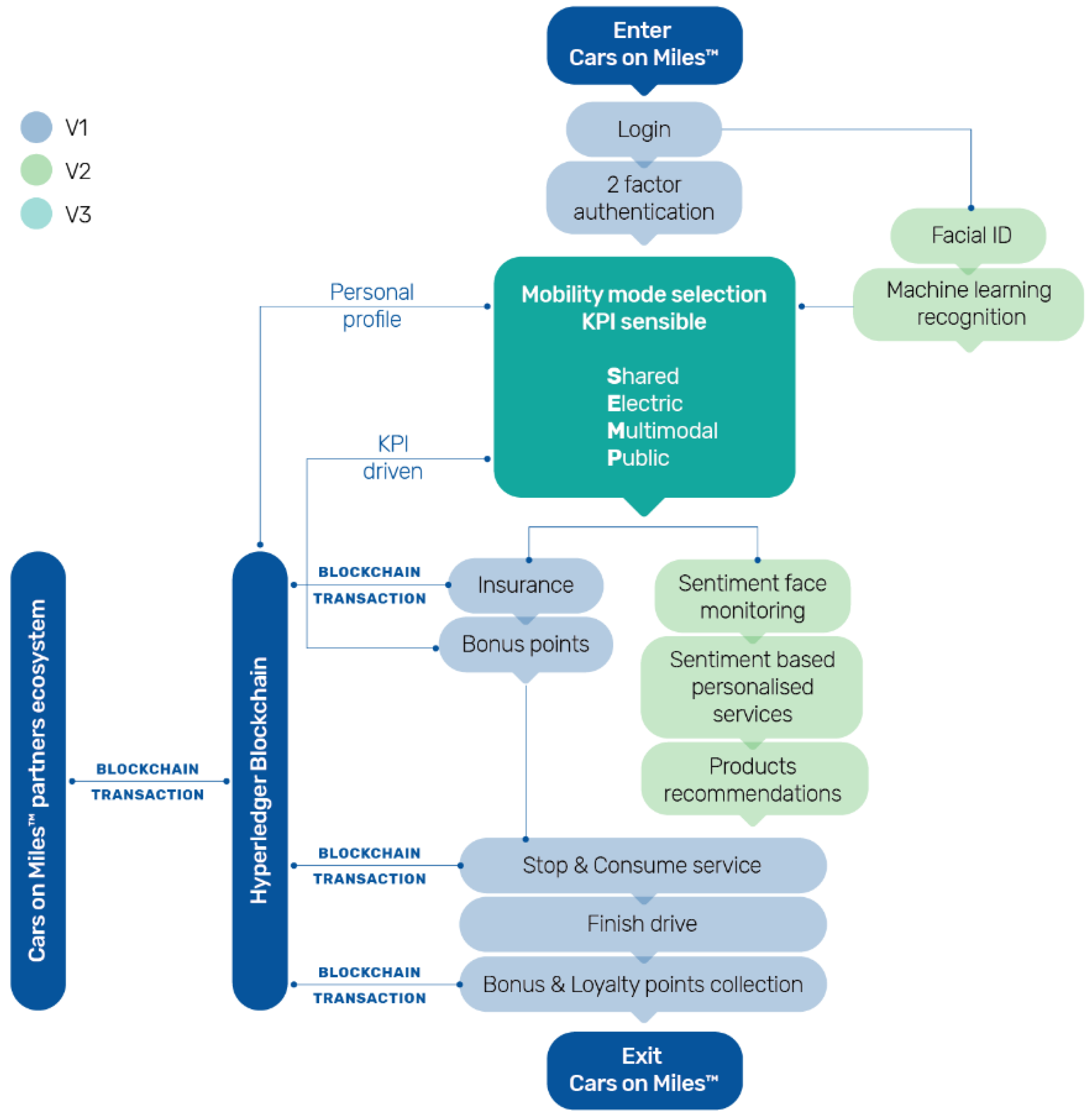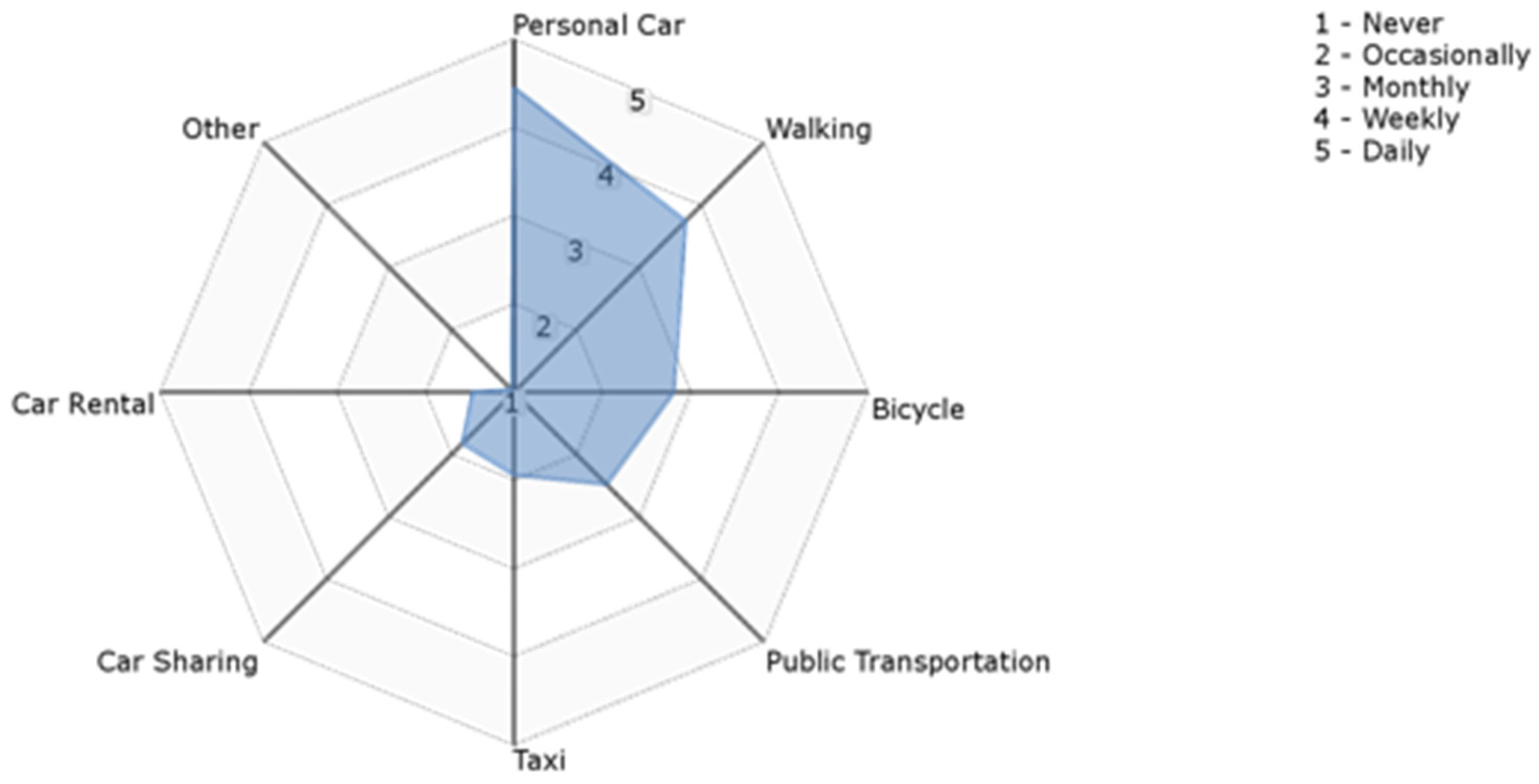2.1. Autonomous Vehicles (AV) and Their Adoption
Nowadays, for passengers as well as pedestrians safety is a key concern in the automobile sector. Advanced technologies enabled the development and implementation of passive and active safety systems, and more recently advanced driver-assistance systems (ADAS) in vehicles [
42,
43].
Based on the safety systems implemented in vehicles, the Society of Automotive Engineers (SAE) classified automated driving on a 5-level scale, with Level 5 (full automation), being the most advanced, requiring no human intervention, even in driving in most demanding environments and under any driving scenarios [
16]. Currently available automated driving technology implemented in cars can be labeled as Level 2—partial automation, and Level 3—conditional automation [
44]. Level 2 (partial automation) is available in current serial production cars, while Level 3 (conditional automation) is available in small-scale produced vehicles [
45]. There are also shuttle buses in operation that are already achieving Level 4 (high automation). For example, the Navya company provides autonomous, driverless and electric solutions for sustainable transportation [
46].
Automated driving is closely related to broader changes going on in transportation systems, a shift towards intelligent road solutions (ITS), active communication between vehicles and infrastructure (V2I), and vehicles to other surroundings in general (V2X). The next generation of cellular communications, 5G, will play a significant role in connected vehicle communication (C-V2X), that already started with the ratification of LTE-V2X (PC5) mode on existing 4G/LTE mobile networks, but will require substantial infrastructure investments [
47].
AV bring many positive impacts in future mobility such as, for example, enhancement of safety [
2,
4,
5,
48], possibilities of transportation for children, older and disabled people [
4,
8,
10], reduction of space required for parking, less congestions on the roads [
20], and possibilities for improvement of efficiency of the mobility system [
48]. In addition, AV, electrification and sharing models are bringing more sustainable mobility solutions [
4,
5,
8,
13,
14].
However, each innovation takes time before its full adoption and driverless vehicles will only become successful if they are accepted by users [
21]. For that reasons several authors investigated perceptions of users of AV from various perspectives. For example, results of the survey of 3500 British transport professionals showed that 88% of respondents expected Level 2 vehicles to be implemented on the roads by the year 2040, while 67% and 30% believed the same for level 3 and Level 4 vehicles; 60% of respondents expected AV to be safer than existing vehicles [
49]. A study among 3308 participants in US found out that approximately one third of the younger adults under 45 years were more open to full automation, while older drivers were more likely to endorse being comfortable with systems that assist the driver and that do not require them to give up control [
28]. Results of the survey among 467 respondents about opinions on AVs in the US showed that approximately 30% of respondents expressed interest in adopting AV technology 4 years after its introduction on the market. The same proportion of respondents were willing to spend more than 5000 USD to adopt full automation in their next vehicle purchase; 82% of the respondents recognized safety as the most important factor affecting their adoption of AV, while legislation (12%) and costs (6%) seemed to be less important inhibiting factors [
24]. A study among 1260 individuals in US found out that the average household is willing to pay about 3500 USD for partial automation and 4900 USD for full automation [
50]. A study among 721 individuals in Israel and North America showed that technology interest, environmental concern, enjoyment of driving, public transit attitude and pro-AV sentiments effect on AVs adoption. This study also showed that early adopters of AVs will likely be young, students, more educated and those willing to spend more time in vehicles. In addition, 75% of individuals would use a shared-autonomous vehicle, if it would be freely available [
51]. Study done among 1603 participants in Germany was focused on analyzing gender differences and effects of anxiety on the willingness to use automated cars [
26,
52]. The majority of 1533 respondents from the UK, USA and Australia thought that AV would result in both fewer and less severe collisions. The participants were most concerned about equipment failures resulting in safety consequences. Furthermore, participants were very concerned about AV offering no control for them to take over driving. The concern seemed to lessen with the smaller vehicles [
53]. Concerns about systems or equipment failure and hacking or misuse of the systems were also detected in other studies [
2,
22,
53]. A survey among 925 participants in UK revealed that 19% of participants were positive towards AVs, while the same percentage were uncertain over computer viruses or hacking, while 18% were conditionally accepting the AV and were still concerned that something could go wrong [
20].
A study among 5000 respondents from 109 countries showed that respondents, on average, found manual driving to be the most enjoyable mode of driving and 33% indicated that fully automated driving would be highly enjoyable. 22% of the respondents disagreed about paying for a fully automated driving system, whereas 5% indicated they would be willing to pay more than
$30,000. It was estimated by 69% of respondents that fully automated driving will reach a 50% market share between now and 2050 [
22]. It is interesting that 3040 survey participants in Denmark preferred car ownership rather than sharing solutions in the future scenarios; 22% of respondents considered also residential relocation as a consequence of the possibility of working in the car [
54]. In addition, 302 survey participants in Germany suggested that private cars, whether conventional or fully automated, will remain the preferred travel mode. Sharing models seem to benefit from full automation more than private cars. In addition, findings indicate that the growth of the sharing model will mainly be in public transport. This shows that for the development of sustainable mobility more emphasis should be placed in making public transport more attractive [
19]. Another study in France surveyed 425 participants. Study revealed that most attractive benefit of automated buses would be lower bus fares because of no driver costs. Two third of study participants would consider taking an automated bus, if both automated and conventional buses were available. Study participants were most concerned about passenger security, considering driving in an automated bus, especially during the night. More than half of the study participants expressed that they would consider using automated cars, if they become available. Three quarters of participants were interested in owning an automated car, while one quarter was more interested in sharing automated cars using services such as car-sharing, car-pooling, or taxis [
27]. The survey of 7755 respondents from 116 countries on their acceptance of driverless vehicles, attitudes towards technology, knowledge of mobility-related developments, and sociodemographic characteristics showed that respondents considered driverless vehicles easy to use and convenient. Respondents would use 100% electric driverless vehicles in public transport. Respondents rated the perceived enjoyment of taking a ride in driverless vehicles positively. Respondents consider retaining some degree of control over the driverless vehicle as important [
21]. This perception is in line with results of the study of Shoettle and Sivak [
53].
A semi-structured interview of 44 passengers who travelled a predefined route in a driverless shuttle bus in Finland showed that a vehicle without a human driver was not considered as a problem for the passengers. Passengers felt safe and secure in the AV. Passengers’ perceptions were similar to when travelling by a metro or a tram, where there are no or very rare interactions with a driver. The results showed that people are much more intolerant of accidents caused by AV than by humans. The study also revealed that positive attitudes towards AV can be supported by giving people possibilities to try AV in a safe, real-life environment [
25]. The next study in a form of semi-structured interviews among 60 participants in Germany showed the growing dominance of multimodal mobility and the declining role of private cars in everyday mobility in dense urban areas. This shows a potential for alternative mobility solutions including car-sharing models [
55].
2.2. Living Labs
Originally the living lab concept (in the context of physical developments) was first mentioned as such by the Massachusetts Institute of Technology (MIT), Boston by professor William Mitchell, MediaLab and School of Architecture and city planning [
33,
56]. The main aim of this concept was to identify and provide the potentials of users’ contribution for successful innovations in production-consumption systems [
56,
57]. In 2005, Living Labs were mentioned in the context of information and communications technology (ICT) solution development. The aim at that time was to bring users and consumers into the system of innovation and benefiting of a larger mass of ideas, knowledge and experiences [
33,
57]. With years, Living Lab as a user-centered innovation ecosystem has been recognized as a potential platform to boost innovation in Europe. Therefore, in November 2006, under the Finnish European Presidency, the European Network of Living Labs (ENoLL) was founded. Today ENoLL counts over 150+ active living labs members worldwide (440+ historically recognized over 12 years). ENoLL facilitates innovation in various domains as for example energy, media, mobility, healthcare, agro-food, tourism etc. As such ENoLL presents a platform for best practice exchange, learning and support, and Living Lab international project development [
58].
The living lab concept refers to human-centered research and development methodology or development approach, where (ICT-based) innovations (services, products or application) are created and validated in collaborative multi-contextual real-world environments [
32,
33]. They are also referred as technologically socio-economic approach [
32,
34,
35,
37,
59], innovation [
60] or experimental platform [
61]. Human in a center is in the focus in various roles as for example a citizen, user, consumer, worker etc. … [
33]. Living lab differs to other human-centric approaches as it puts users in the center of co-design process, where users and developers (and other stakeholders) actively work together creating the new solutions [
33,
59,
62]. Living labs are usually ICT driven, and therefore stakeholders jointly develop and test new and innovative technological developments within the framework of a co-design and an open innovation processes [
57,
60]. Another important characteristic of a living lab is that it involves a large variety of stakeholders as for example university and research organizations, small and medium enterprises (SMEs), industry, ICT enterprises, civic sector and public partners and engage them into the co-creation of innovation [
32,
38,
39]. The living lab approach is thus based on the quadruple helix model of (innovation) partnership, where government, industry, the public and academia work together and produce innovative solutions [
57,
63]. Recently also cities around the globe adopted these concepts and became platforms for innovation economy. The City as a Lab is a new and unique concept that goes beyond an internal/external lab environment and is transferred to a whole city ecosystem. Cities are increasingly becoming living laboratories for rapid prototyping, applying novel digital technologies and testing innovations for complex challenges [
64].
Living labs as a real-world innovation environments address certain thematic as well as spatial areas [
57]. Therefore, it is not surprising that living labs can be found also in the field of smart mobility. Besides AV Living Lab in Slovenia, there are also other living labs as for example the Smart mobility living lab in London [
65], the Israel living lab for smart mobility [
66], TUM (Technical University Muenchen)-living lab connected mobility [
67] and the Catalonia living lab for connected and automated driving [
68].













